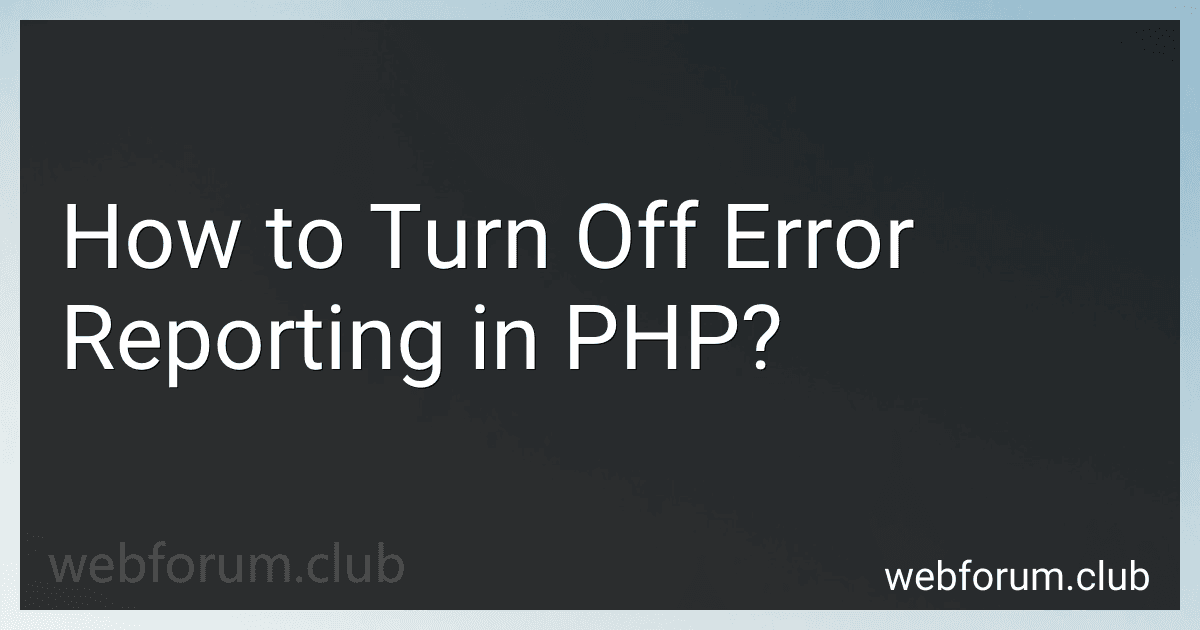Error reporting in PHP allows developers to receive detailed information about errors, warnings, and notices that occur during script execution. It helps in locating and fixing issues in the code, improving the overall quality of the application.
When error reporting is turned on, PHP generates error messages with valuable information such as the error type, line number, file name, and a description of the error. There are different levels of error reporting defined in PHP, and each level determines the types of errors that are displayed.
The error_reporting() function is used to specify the level of error reporting. It takes a numeric value or a named constant as an argument. Some commonly used error reporting levels are:
- E_ALL: This reports all types of errors, warnings, and notices.
- E_NOTICE: This reports only notices, which are minor issues that do not necessarily cause script execution to fail.
- E_WARNING: This reports only warnings, which are more serious issues that may affect the functionality of the script.
- E_ERROR: This reports only fatal errors that cause script execution to terminate.
To enable error reporting, the error_reporting() function should be called at the beginning of the script or can be set in the php.ini file. For example, to enable reporting of all types of errors, you can use the following code:
error_reporting(E_ALL);
It is important to note that error reporting should be enabled during development but should be disabled or set to a lower level in production environments to prevent sensitive information from being displayed to users.
In addition to error reporting, PHP also provides error handling mechanisms such as the try-catch block for catching and handling exceptions, and the error_log() function for logging errors to a file or email. These features further help in identifying and resolving issues in PHP applications.
How to handle errors in PHP?
To handle errors in PHP, you can use the error handling functions provided by PHP. Here are some common methods:
- Error Reporting: Enable error reporting by setting the error_reporting and display_errors directives in your PHP configuration file (php.ini) or within your code using the error_reporting() and ini_set() functions, respectively. Depending on your development and production environment, you may want to display errors during development and log them silently in production.
- Error Types: PHP categorizes errors into different types like E_NOTICE, E_WARNING, E_ERROR, etc. You can control which types of errors are reported using the error_reporting() function or the error_reporting directive in php.ini.
- Try-Catch Blocks: Use try-catch blocks to catch and handle exceptions. This is particularly useful for handling exceptions in code segments that may throw exceptions, such as database operations or file handling. Place the code that may throw an exception inside the try block and provide corresponding catch blocks to handle specific exceptions.
try { // Code that may throw exception } catch (ExceptionType $e) { // Handle the exception }
- Custom Error Handler: PHP allows you to define a custom error handler function using the set_error_handler() function. This function will be called whenever a non-fatal error occurs, giving you the ability to handle errors according to your own logic.
// Custom error handler function function customErrorHandler($errorNo, $errorMsg, $errorFile, $errorLine) { // Handle the error }
// Set the custom error handler set_error_handler("customErrorHandler");
- Logging: Log errors to a file for easier debugging and tracking. You can use the error_log() function to log errors to a file.
// Log error to a file error_log("Error message", 3, "/path/to/error.log");
- Error Pages: Create custom error pages to display user-friendly error messages when fatal errors occur. You can redirect the user to these error pages using the header() function with the appropriate HTTP status codes.
// Redirect to custom error page header("Location: error.php", true, 301); exit;
Remember that error handling should be tailored to your specific application and error scenarios.
How to Turn Off Error Reporting in PHP?
To turn off error reporting in PHP, you can follow the steps below:
- Locate your PHP configuration file (php.ini). This file is usually located in the root directory of your PHP installation, but its location can vary depending on your system setup and configuration.
- Open the php.ini file in a text editor.
- Search for the following line in the php.ini file: error_reporting = E_ALL This line sets the level of error reporting to display all types of errors. To turn off error reporting, you need to modify this line.
- Replace the line with the following code to turn off error reporting completely: error_reporting = 0 This will prevent any errors from being displayed or logged.
- Save and close the php.ini file.
- Restart your web server for the changes to take effect.
Note: Modifying the php.ini file affects the entire PHP installation, so it will disable error reporting for all PHP scripts on your server. If you only want to disable error reporting for a specific PHP script, you can use the following code at the beginning of your script:
error_reporting(0); ini_set('display_errors', 0);
This code will override the PHP configuration settings for error reporting for that particular script.
